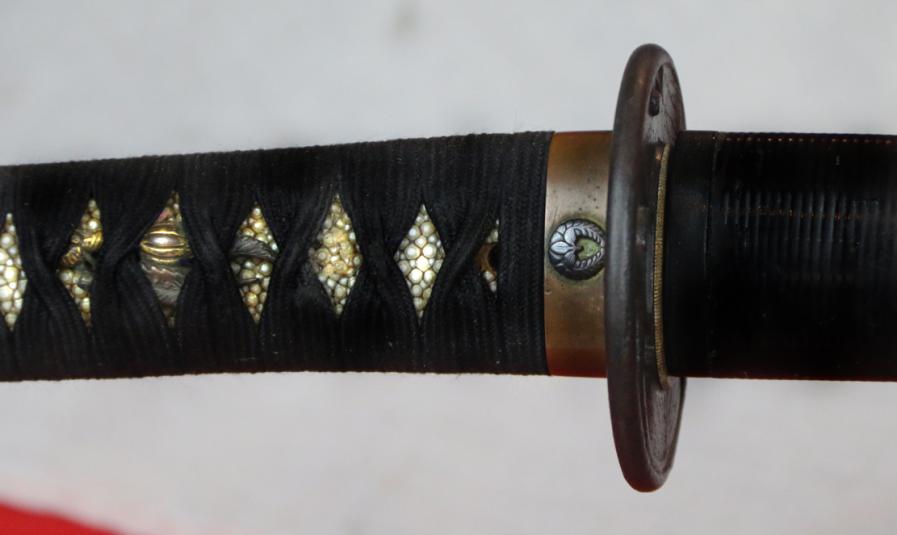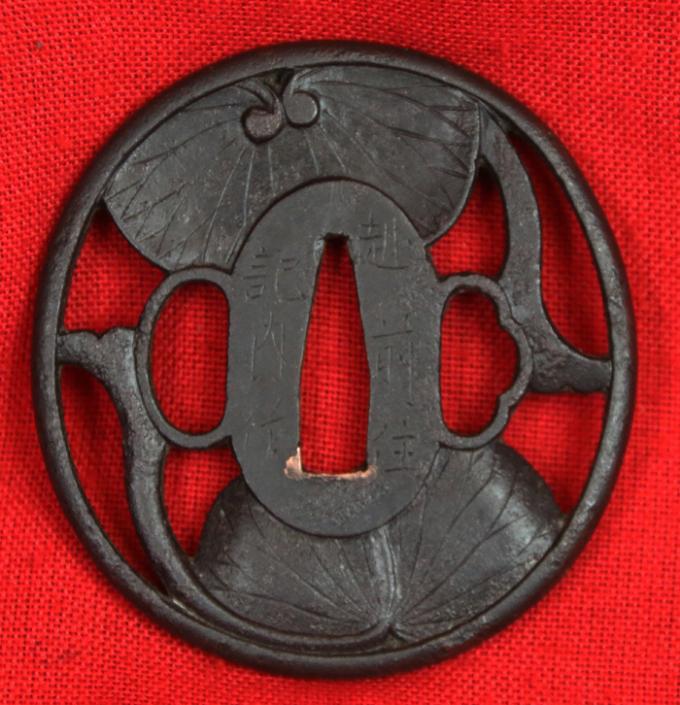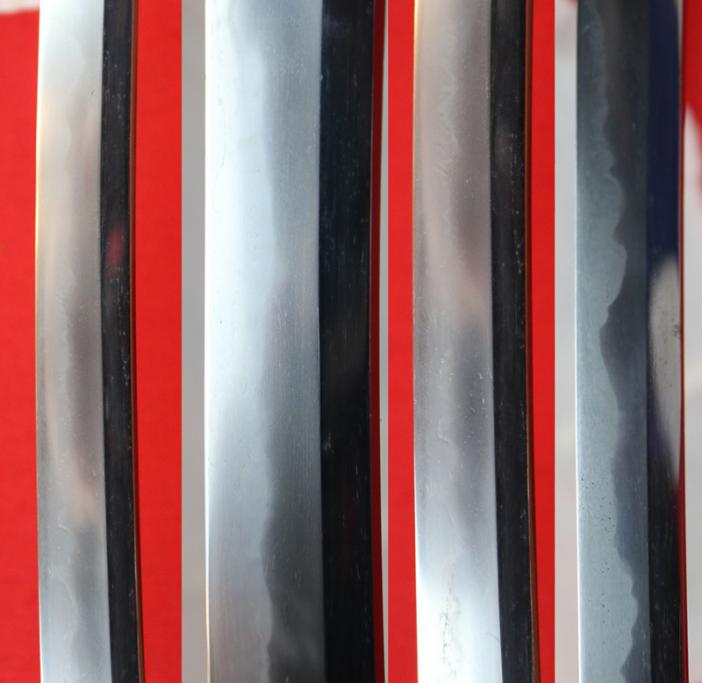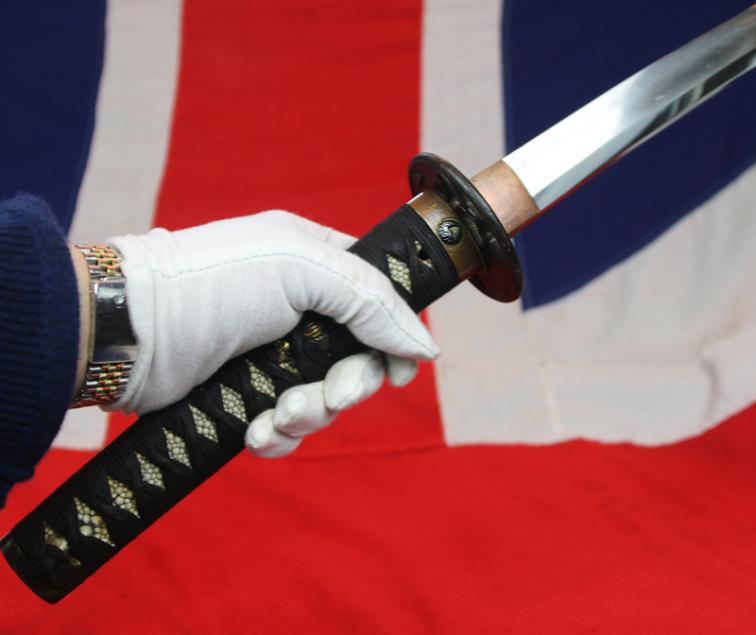A Very Fine & Long 15th Century Katana, Around 600 Years Old, From An Historically Significant Great Samurai Clan, The Nabeshima Descendents of the Fujiwara, With Traditional Stone Polished Blade
The blade was sent to Japan some years ago for a fine stone traditional re polish. This superb ancient blade has a stunningly elegant curvature, and combined with a simply spectacular, vibrant and deep hamon, absolutely breathtaking, and very healthy for its age, and thus it makes this blade very special indeed, it is also very unusual for a blade of this age to survive its great length without alteration. The blade was fully traditionally stone polished. It has all its original Edo fittings, and its fine signed tsuba by Kinai of Echizen. It bears two mon, one in silver, 'Daki Myoga' mon of the great Nebeshima clan on the kashira, and the 'Sagarifuji' mon of the Fujiwara clan on the fuchi. The Nabeshima clan was a cadet branch of the Shoni clan and was descended from the Fujiwara clan. The Fujiwara became so powerful they had absolute control over the Imperial court. By the year 1000, Fujiwara no Michinaga was able to enthrone and dethrone emperors at will, effectively, "hereditary dictators". The Fujiwara controlled the throne until the reign of Emperor Go-Sanjō (1068–73), the first emperor not born of a Fujiwara mother since the ninth century. Emperor Go-Sanjō, determined to restore imperial control through strong personal rule, implemented reforms to curb Fujiwara influence. In the late 12th century, Fujiwara no Sukeyori, a descendant of Fujiwara no Hidesato in the 9th generation, received the title of Dazai Shoni (equivalent to that of vice-governor of the military government of Kyushu) from Shogun Minamoto no Yoritomo, and the title became the family name.
The clan played an important role in the region as early as the Muromachi period, when it helped suppress opposition to the Ashikaga shogunate's control of Kyushu. It did not take the name Nabeshima, however, until the late 15th century, when Shoni Shigenao established himself at Nabeshima in Hizen province (today part of Saga City, Saga prefecture). Later, in the Sengoku period (1467-1603), the Nabeshima were one of a number of clans which clashed over the island. The Nabeshima sided with the Ryuzoji clan against the Otomo clan, though this ultimately ended in failure and the death of Ryuzoji Takanobu at the 1584 battle of Okita Nawate. Several years later, however, the Nabeshima recovered power and prominence by aiding Toyotomi Hideyoshi in his 1587 invasion of Kyushu; Nabeshima Naoshige was granted the region of Saga as his fief, as a reward for his efforts. Naoshige also contributed to Hideyoshi's invasions of Korea in the 1590s.
The clan initially aided Ishida Mitsunari against Tokugawa Ieyasu in the Sekigahara Campaign in 1600. However, they switched sides to support the Tokugawa, who were ultimately victorious, before the campaign had ended, battling and occupying the forces of Tachibana Muneshige, who was thus prevented from contributing directly to the battle of Sekigahara. Though regarded as tozama daimyo ("outside" lords), and assigned particularly heavy corvee duties, the Nabeshima were allowed to keep their territory in Saga, and in fact had their kokudaka increased. The clan's forces served the new Tokugawa shogunate loyally in the years which followed; they remained in Kyushu during the 1615 Osaka Campaign as a check against a possible rebellion or uprising by the Shimazu clan, and aided in the suppression of the Shimabara Rebellion of 1637. In recognition of their service, members of the clan were granted the prestigious family name Matsudaira in 1648.
During the Edo period, the clan's Saga domain became quite famous. There is a stunning picture in our gallery of a painting in the British Museum, by an unknown artist, of Portrait of a Nabeshima lord, Fujiwara; Munemitsu of the Nabeshima clan wearing his tanto, with it's Nabeshima 'Daki Myoga' mon. The sukashi round tsuba is signed Echizen no Ju Kinai Saku, in the form of an aoi, or hollyhock plant, possibly by godai Ishikawa. Likely a branch of the Miōchin (Group IV), this family was founded by Ishikawa Kinai, who moved from Kiōto to Echizen province Japanese text and died in 1680. The succeeding masters, however, bore the surname of Takahashi. All sign only Kinai Japanese text, with differences in the characters used and in the manner of writing them.
The Kinai made guards only, of hard and well forged iron usually coated with the black magnetic oxide. They confined themselves to pierced relief showing extraordinary cleanness both of design and execution. Any considerable heightening of gold is found as a rule only in later work. Dragons in the round appear first in guards by the third master, fishes, birds, etc., in those of the fifth; while designs of autumn flowers and the like come still later. There are examples of Kinai tsuba in the Ashmolean and the British Museum. Very long 30.75 inch unsigned blade, measured tsuba to tip.
Code: 23298
9850.00 GBP










